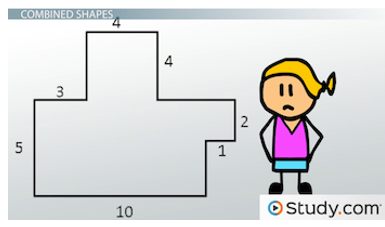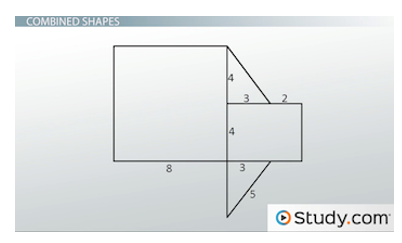
Example of combined shapes
We know the lengths of some of the sides, but not all of them. But, look closer at the shape. It's actually a combined shape comprised of a group of squares and rectangles.
In the top square, we know two sides are 4 miles, so the other side must also be 4 miles. As for the bit below it, well, we know the entire length of that rectangle is 10 miles. If two sections are 3 and 4, then the missing part must be 3 miles.
And, on the part on the side, the small length is going to be equal to the opposite side of the small rectangle, so it's 1 mile. Finally, the remaining part is just 5 minus 2, or 3 miles. So, now we know all the sides! It's 4 + 4 + 4 + 3 + 1 + 2 + 1 + 3 + 10 + 5 + 3, or 40 miles. Holy cow! That's way farther than you planned. I think you earned some ice cream.
Now, let's say you wake up the next day and all you can do is hobble around your house, leaning on walls for support. But, you still want to know how far you're moving, since every step hurts. Since you live in a geometry lesson, your house has some challenging geometric qualities. You can do this! You know a few parts, which is all you need. Just break it up into shapes like this:

Another example of combining shapes to find perimeter
Let's start with the big one. One side is 8 feet. Then, you can see that the two 4-foot stretches add up to 8, so that's a square. That means all sides are 8 feet long. As for the rectangle, well, one side is 4, so the opposite side is 4. If the other side is 2 and 3, then the missing piece is also 2.
Finally, those pesky triangles. But wait, those are special triangles. First, they're right triangles. But, more than that, look at the two legs of the top one. They are 3 and 4 feet, which makes it a 3-4-5 triangle. So, the hypotenuse is 5 feet. If you forget what a 3-4-5 triangle is, you could also use the Pythagorean theorem, or a^2 + b^2 = c^2. 3^2 + 4^2 is 25. The square root of 25 is 5.
Then, there's the final triangle. This is also a 3-4-5 triangle, so the missing side is 4 feet. If you put everything together, it's 8 + 8 + 8 + 5 + 2 + 4 + 2 + 5 + 4, or 46 feet. Between all that running, walking and geometry, I think you earned extra ice cream today.
Lesson Summary
In summary, if you know the lengths of all the sides of a shape, simply adding them together will give you the perimeter.
With a regular quadrilateral, like a square or a parallelogram, you just need to know one or two sides, and you can figure out the rest.
With an irregular shape, the perimeter is still just the sum of all the sides. If you don't know all the lengths, look to see if you can break it up into a group of combined shapes. Then use the properties of those shapes to determine the missing sides.